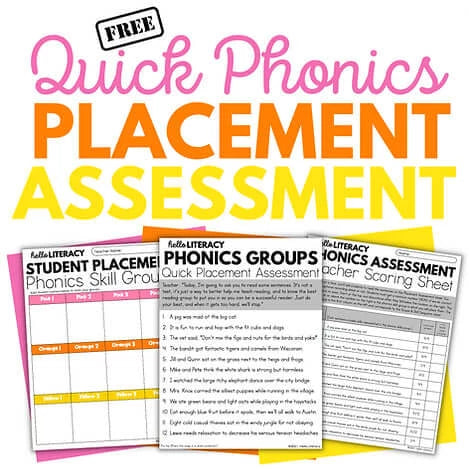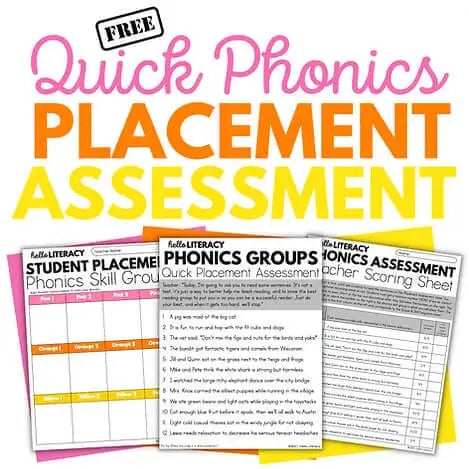
· By Jen Jones
Mastering Phonics Assessments in West Virginia Schools
Mastering Phonics Assessments in West Virginia Schools
West Virginia phonics assessments are essential tools for evaluating and advancing young learners' reading abilities. These assessments focus on decoding skills such as CVC words, consonant blends, digraphs, and r-controlled vowels. Here's a quick overview:
- Scope: Covers skills from simple CVC words to complex multisyllable words.
- Sequence: Skills progress from simple to complex.
- Standards: Aligned with the West Virginia College- and Career-Readiness Standards.
- Monitoring: Includes 10 Progress Monitoring Assessments designed to track learning.
Phonics assessments are crucial because they help identify students' strengths and areas needing improvement. According to Laura Stewart from The Reading League, "choosing appropriately complex texts and expanding vocabulary are key." This ensures instruction is tailored, helping children achieve reading proficiency and enjoy academic success.
As an expert educator and literacy specialist, I am Jen Jones, with over 30 years of experience in literacy instruction. My work with West Virginia phonics assessments has empowered countless teachers and students, ensuring a structured approach to reading.

Understanding West Virginia Phonics Assessments
What is West Virginia Phonics?
West Virginia Phonics is a structured, research-based approach to teaching phonics, ensuring students develop essential reading skills. It follows a Scope & Sequence that progresses from simple to complex phonics skills. This method is rooted in the science of reading, emphasizing explicit, systematic instruction.
The program covers various phonics skills, including:
- CVC words (consonant-vowel-consonant)
- Consonant blends
- Digraphs (ch, sh, th, wh, ph, ck)
- CVCe words (consonant-vowel-consonant-silent e)
- Predictable vowel teams (au/aw, ai/ay, igh/y, oy/oi, ew/ue, oa)
- Unpredictable vowel teams (ea, ie, oo, ou, ow)
- R-controlled vowels
- Complex consonants (hard/soft g, hard/soft c, tch, wr, kn, gn)
- Multisyllable words (c+le, open, closed)
This method uses multisensory teaching techniques to engage students through visual, auditory, and kinesthetic activities, enhancing their understanding and retention of phonics skills.
Key Components of Phonics Assessments
Phonics assessments in West Virginia schools are designed to monitor student progress and ensure mastery of phonics skills. Here are the key components:
Scope and Sequence
The Scope and Sequence of West Virginia Phonics provides a clear roadmap for instruction. It starts with basic phonics skills and gradually introduces more complex concepts. This ensures students build a strong foundation before moving on to more challenging material.
Standards
West Virginia Phonics aligns with the West Virginia College- and Career-Readiness Standards. These standards ensure that phonics instruction is consistent and meets the educational requirements set by the state. According to the West Virginia Department of Education, this alignment helps educators deliver high-quality, standards-aligned instruction.
Progress Monitoring
Progress Monitoring is a crucial part of phonics assessments. It involves regular assessments to track students' progress and identify areas where they may need additional support. The program includes 10 Progress Monitoring Assessments that align with the explicit teaching of various phonics skills.
For example, assessments cover:
- Letter Sound recognition
- Word Family identification
- Phoneme Segmentation
These assessments help teachers tailor their instruction to meet the individual needs of their students. As Kimberly Hunt demonstrates in her phonics segmentation video, breaking down words into their phonemes can significantly enhance students' reading abilities.
Multisensory Teaching
West Virginia Phonics incorporates multisensory teaching methods to engage students in learning. This approach uses visual aids, auditory cues, and hands-on activities to help students grasp phonics concepts more effectively. For instance, using sound decks for visual and auditory drills can reinforce the connection between letters and sounds.
By integrating these components, West Virginia Phonics assessments provide a comprehensive approach to phonics instruction, ensuring that students develop the necessary skills to become proficient readers.

In the next section, we will explore how to conduct effective phonics assessments and provide practical strategies for teachers to implement in their classrooms.
Implementing Effective Phonics Assessments
How to Conduct Phonics Assessments
Conducting phonics assessments effectively requires a structured approach. Here are some best practices and strategies to ensure you get the most accurate and useful results:
1. Preassessment: - Before diving into phonics instruction, gauge where your students stand. Use a Quick Placement Assessment (QPA) to quickly identify which phonics skills your students know and which ones they need to work on. - This assessment includes a student copy, teacher scoring sheet, directions for administering and scoring, a group placement grid, and a next steps document.
2. Monitoring Tools: - Regular progress monitoring is crucial. Incorporate Progress Monitoring Assessments aligned with the explicit teaching of West Virginia Phonics skills such as CVC words, consonant blends, and digraphs. - These tools help track student progress over time and adjust instruction as needed.
3. Student Page: - Create a dedicated student page for each learner. This page should include their assessment results, progress tracking, and specific areas for improvement. - Use visual aids like sound strips and mapping mats to assist students in understanding and internalizing phonics concepts.
Tools and Resources for Phonics Assessments
Having the right tools and resources at your disposal can make a significant difference in the effectiveness of your phonics assessments. Here are some key resources to consider:
1. Assessment PDFs: - Utilize downloadable PDFs for various phonics assessments. These should include detailed instructions, scoring sheets, and student pages. - Ensure that these resources are easily accessible and organized in a binder cover for quick reference.
2. Tracking Pages: - Maintain comprehensive tracking pages to monitor each student's progress. These pages should include dates of assessments, scores, and notes on student performance. - Use these tracking pages to inform your instruction and provide targeted support where needed.
3. Binder Cover: - Organize all your assessment materials in a binder with a clear cover for easy identification. This ensures that all your resources are in one place and easily accessible.
By implementing these strategies and utilizing these tools, teachers can conduct effective phonics assessments that provide valuable insights into student progress. This structured approach ensures that all students receive the support they need to become proficient readers.

In the next section, we will delve into the Floss Rule and its role in phonics assessments, exploring its importance and application in the classroom.
The Floss Rule and Its Role in Phonics Assessments
Importance of the Floss Rule in Assessments
The Floss Rule is a simple yet crucial spelling rule in phonics. It states that when a one-syllable word ends in a short vowel followed by the sounds /f/, /l/, or /s/, you double the final consonant. For example, "stuff," "ball," and "pass" all follow this rule.
Examples: - Stuff: short vowel "u" followed by /f/ - Ball: short vowel "a" followed by /l/ - Pass: short vowel "a" followed by /s/
Application:
In phonics assessments, understanding the Floss Rule helps students spell words correctly and recognize patterns in word structure. This rule is integrated into various assessment types, such as letter sound assessments and word family assessments.
Memory Aids:
Using memory aids can make the Floss Rule easier for students to remember. A popular mnemonic is "Sammy Loves Funny Stuff," where each word ends with a doubled consonant. Visual aids like charts and flashcards can also reinforce this rule.
Spelling Rules:
The Floss Rule is part of a broader set of spelling rules that students learn in phonics. Mastery of these rules supports accurate spelling and reading fluency. It’s essential to teach this rule explicitly and provide ample practice opportunities.
Assessment Integration:
Incorporating the Floss Rule into phonics assessments is straightforward. Include words that follow the rule in spelling tests and reading passages. For example, during a progress monitoring assessment, you might ask students to spell words like "fluff" or "bell."
Assessments should also check for understanding by including words that do not follow the Floss Rule, ensuring students can differentiate and apply the rule correctly.
By embedding the Floss Rule into regular assessments, teachers can gauge student understanding and provide targeted support where needed. This method ensures that foundational spelling rules are solidified, contributing to overall literacy development.
Frequently Asked Questions about West Virginia Phonics Assessments
Where can I find free West Virginia phonics lessons?
You can access free West Virginia phonics lessons on platforms like Tools 4 Reading and Teachers Pay Teachers. These resources offer various lesson plans, activities, and assessment tools that align with the West Virginia Phonics standards. For instance, Hello Decodables provides a free library of phonics resources, including assessment PDFs and tracking pages.
Is West Virginia phonics research-based?
Yes, West Virginia phonics is research-based and aligned with the College- and Career-Readiness Standards. The program incorporates multisensory teaching methods, ensuring that students engage with the material through visual, auditory, and kinesthetic activities. This approach is supported by the Science of Reading research, which emphasizes the importance of systematic and explicit phonics instruction.
What assessments are used for phonics?
Phonics assessments in West Virginia include Letter Sound Assessments and Word Family Assessments. These tools help teachers monitor student progress and identify areas needing improvement. For example, the Quick Placement Assessment (QPA) is a valuable resource that quickly determines which phonics skills students know and which they need to work on. Additionally, progress monitoring tools like student pages and tracking sheets ensure ongoing assessment and targeted instruction.
By leveraging these assessments, educators can provide effective, data-driven phonics instruction that meets the needs of all students.
Conclusion
Phonics assessments are a cornerstone of effective reading instruction in West Virginia schools. By using tools like Letter Sound Assessments and Word Family Assessments, educators can pinpoint students' strengths and areas for improvement. These assessments, such as the Quick Placement Assessment (QPA), are essential for tailoring instruction to meet each student’s needs.
Phonics mastery is crucial for developing fluent readers. When students grasp phonics, they can decode words more easily, which boosts their reading confidence and comprehension skills. This foundation sets the stage for academic success across all subjects.
At Hello Decodables, we are committed to supporting educators with high-quality phonics resources. Our West Virginia Best Decodable Books are designed to align with the latest research and standards, ensuring that all students can achieve reading proficiency.
By integrating structured phonics assessments and resources, we can help every child in West Virginia become a confident, capable reader. Let's continue to prioritize phonics mastery and provide our students with the tools they need to succeed.
